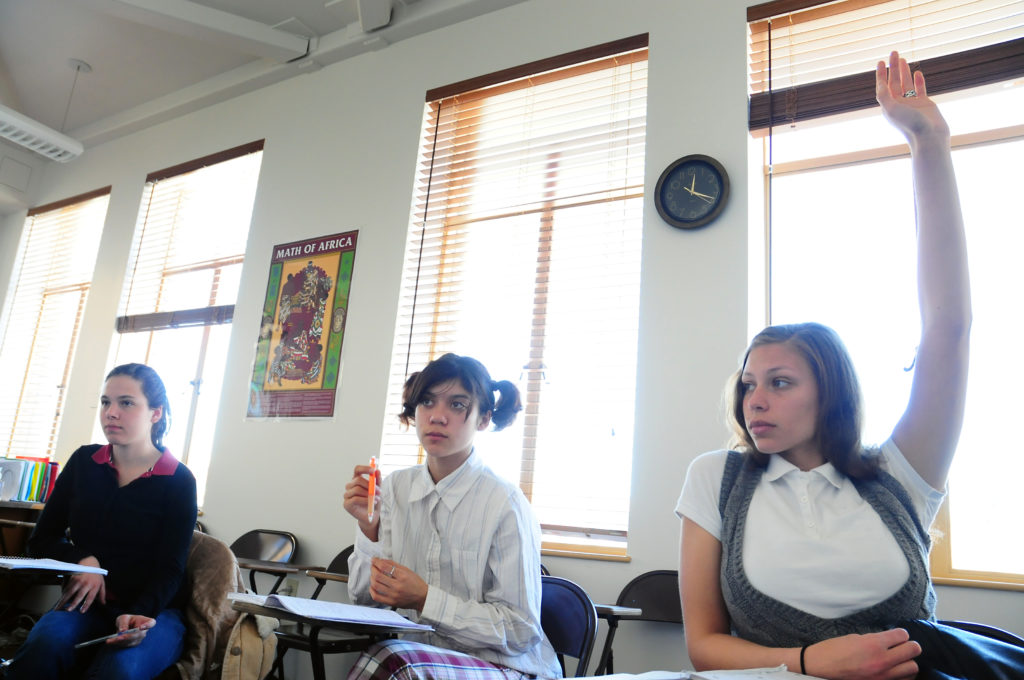
At ConnectED we recognize that there is a well-documented and persistent relationship between success in 9thgrade mathematics, Algebra I or equivalent, and success accessing and persisting in post-secondary learning. Meaning also that those students who struggle in Algebra I are less likely to graduate high school, less likely to enter post-secondary learning, and less likely to matriculate. For students of color and multilingual learners these correlations are even more robust. Consequently, we strongly believe that in order for all students to gain access to and succeed in both college and career, they must be well prepared to tackle mathematics when they enter high school. To this end, we have been focusing our efforts on supporting robust and cognitively rich middle school learning opportunities.
We have been working with the San Diego Enhanced Mathematics Initiative for 3 years, supporting math departments to pilot a new mathematics curriculum and revolutionize their approach to mathematics teaching and learning. As we slowly emerge from Covid conditions we have been able to re-engage in some of our face-to-face based instructional support work.
I recently had the pleasure of participating in Instructional Rounds, where we got to visit several classrooms and see teachers in action. I want to share a highlight here.
We entered the classroom in the middle of the lesson. The teacher was bringing the students back together to discuss the most recent problem that they had been working on. The prompt was to share expressions using exponents that are equivalent to 81. She asked students to share their thoughts and several students immediately shot their hands up into the air. As the teacher took responses from each student she collected and displayed each student’s response.
9^2
3^4
8^11
This practice honors each students’ contribution and values diversity of thought in a public way. But more than this, the teacher was genuinely curious and excited about how each student was thinking. At one point the teacher asked a particular student to share. The student was reticent because they had realized that “it didn’t work.” To which the teacher replied “I know, but I wanted you to share because you only changed one little thing.” The student then shared and the response then prompted the class to have a rich discussion about the order of operations. Even when a student’s result was incorrect the teacher resisted the temptation to correct the answer and instead got curious, digging deeper to better understand the nuggets of knowledge that were making its way to the surface of this student’s way of thinking. This teacher’s enthusiasm was so infectious I could see that most students, if not all the students, wanted to engage and to share their thinking with each other.
I asked this teacher if she would be willing to share a little bit about her journey, her reflections on the curriculum and her experience being a learner in the piloting process. Below is the interview:
Me: Tell us a little bit about where you teach?
Teacher: I currently teach at Challenger Middle School, located in the heart of Mira Mesa. It is located along the northernmost boundary of the school district. It is a community where families, in general have high expectations for their students. We consistently are one of the highest performing schools in the district and have been named a California Distinguished School on several occasions.
Me: What has been your experience with the Illustrative Mathematics (IM) curriculum and San Diego Enhanced Mathematics initiative?
Teacher: I have been working with the Illustrative Mathematics curriculum for the last 3 years, however I have been using tasks from Illustrative Mathematics to supplement my lessons for much longer. I was actually one of the first educators to bring this curriculum to the district’s attention. I have found that while Illustrative Mathematics provides a good backbone for a course, by itself it is insufficient. There is not nearly enough practice, and sessions of direct instruction are necessary for students to master the various procedures that are needed to understand the underlying principles. In working with the Illustrative curriculum I have seen student understanding and engagement increase. The way they introduce the topics is easily accessible to all students which allows everyone to learn something. Even my students with the greatest struggles are usually excited by the first few lessons of a unit. These positive experiences give them something to connect to when other lessons seem more difficult. I also love that the complexity of the tasks significantly increases by the end of the unit. This gives appropriate challenge to those students who need it. I think that Illustrative would have the best outcomes in a fully de-tracked environment. My classes that have the greatest spread of abilities are the ones that I see getting the most benefit from the course.
Me: How has your professional learning experience been with San Diego Enhanced Mathematics and ConnectED?
Teacher: My experience has been mixed. I enjoy, and benefit from, the opportunity to work with other educators who are also passionate about changing the current state of mathematics education. I appreciate the push from the leadership to reevaluate my stance and consistently evolve to meet the needs of today’s students and those of the future. However, I am also frustrated by the leadership as they frequently have no answers to my questions. Teachers need practical solutions designed to be carried out by a single teacher working with 30+ students and in only about 50 minutes of time.
Me: Is there a particular part of your practice that you are working on right now, or that you have worked on in the past, a Problem of Practice that you can share with us? And how does working with Illustrative Mathematics enable you to work on the problems of practice?
Teacher: A difficulty that I am having involves students with disabilities, particularly some students with Autism and those with speech and language issues. The methodology of teaching presented in the Illustrative Mathematics lesson plans relies heavily on students having productive conversations to further their thinking. The majority of the aforementioned students tend to struggle in this environment.
Me: Is there anything else you think the field might find interesting or inspiring that you would like to share?
Teacher: Working with this curriculum and with the Initiative represents a big shift from rote memorization of mathematical procedures to the understanding of the underlying principles of mathematics. This is a profound challenge for all involved. Students, parents, and teachers alike. I hope that at the end of this swing of the pendulum, we might realize that a bit of both are necessary; both building conceptual understanding through discovery learning, productive struggle as well as providing opportunities to then practice with the formalized algorithms.
)